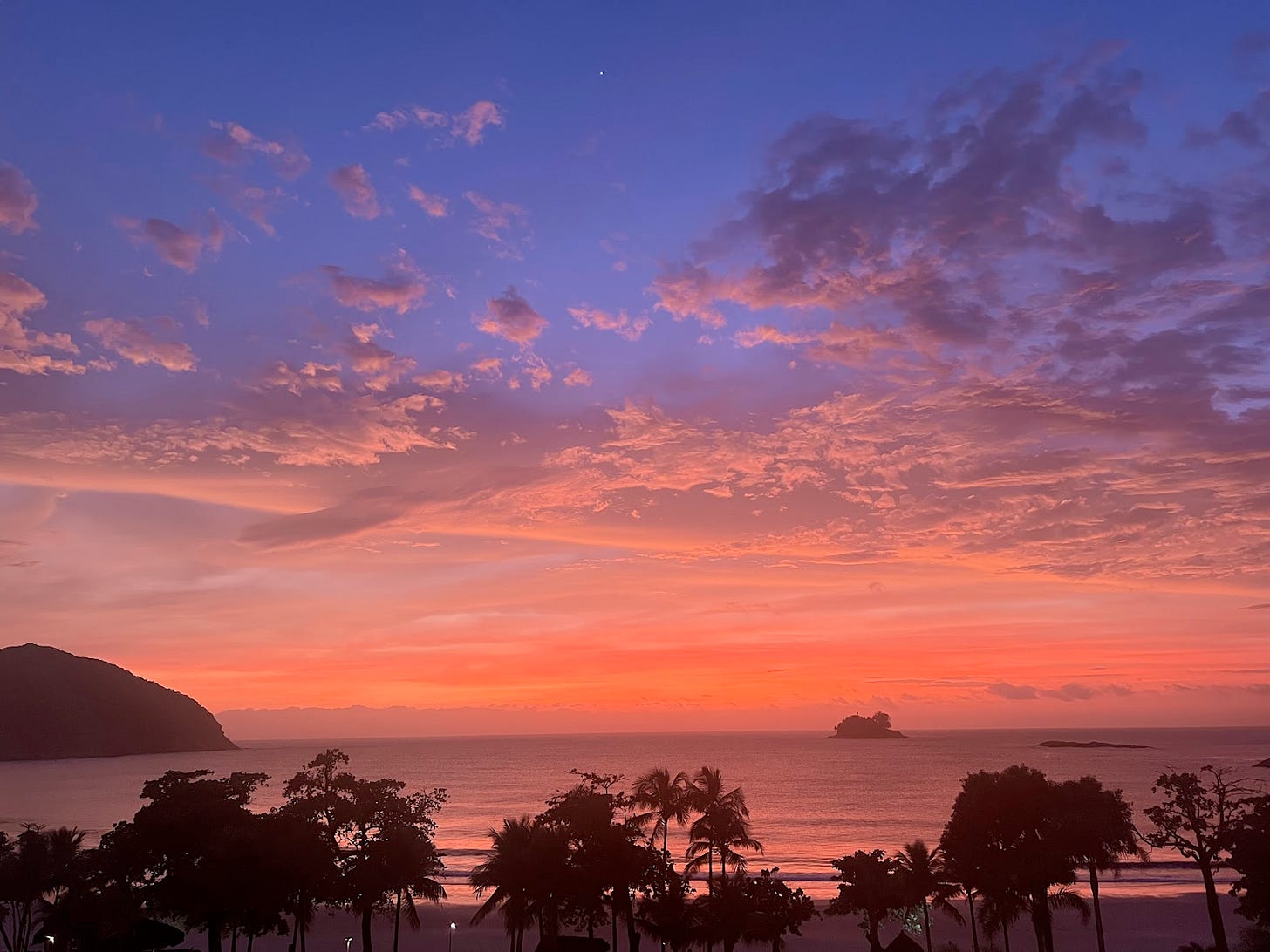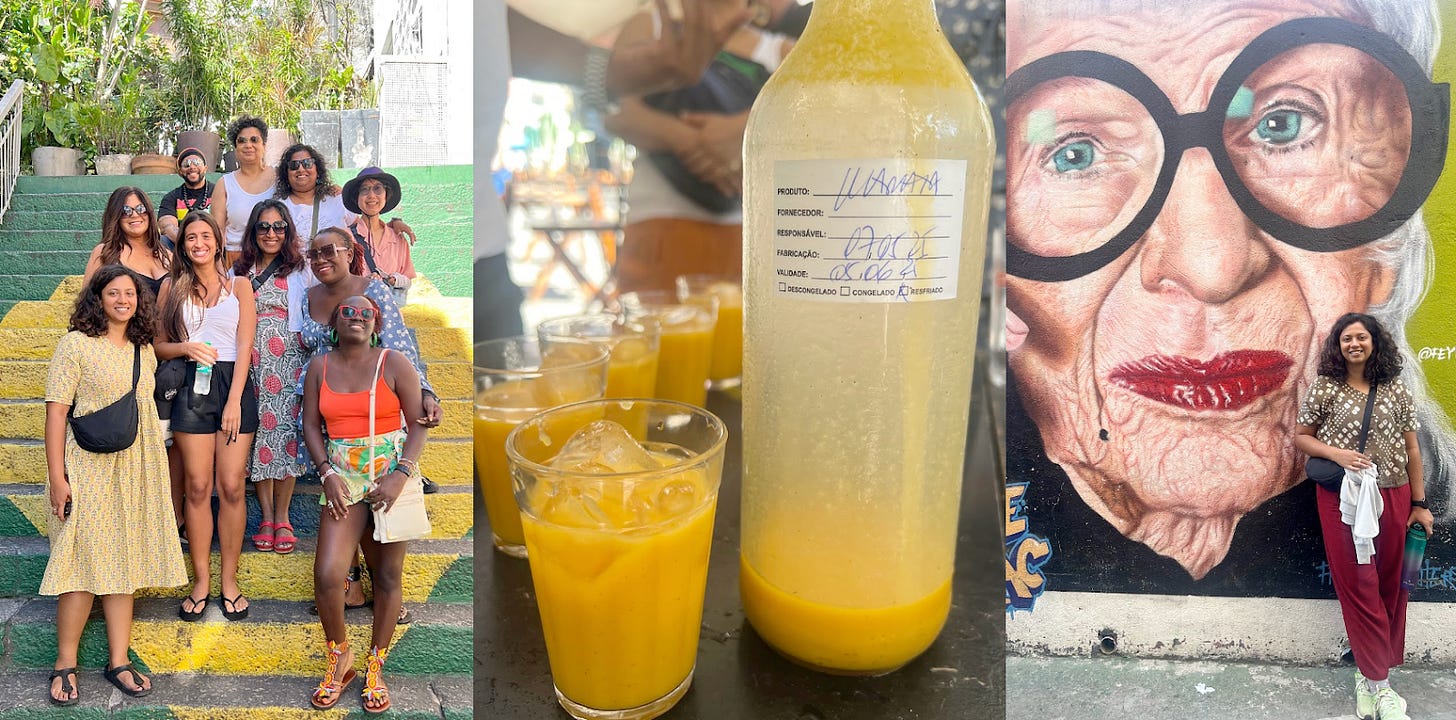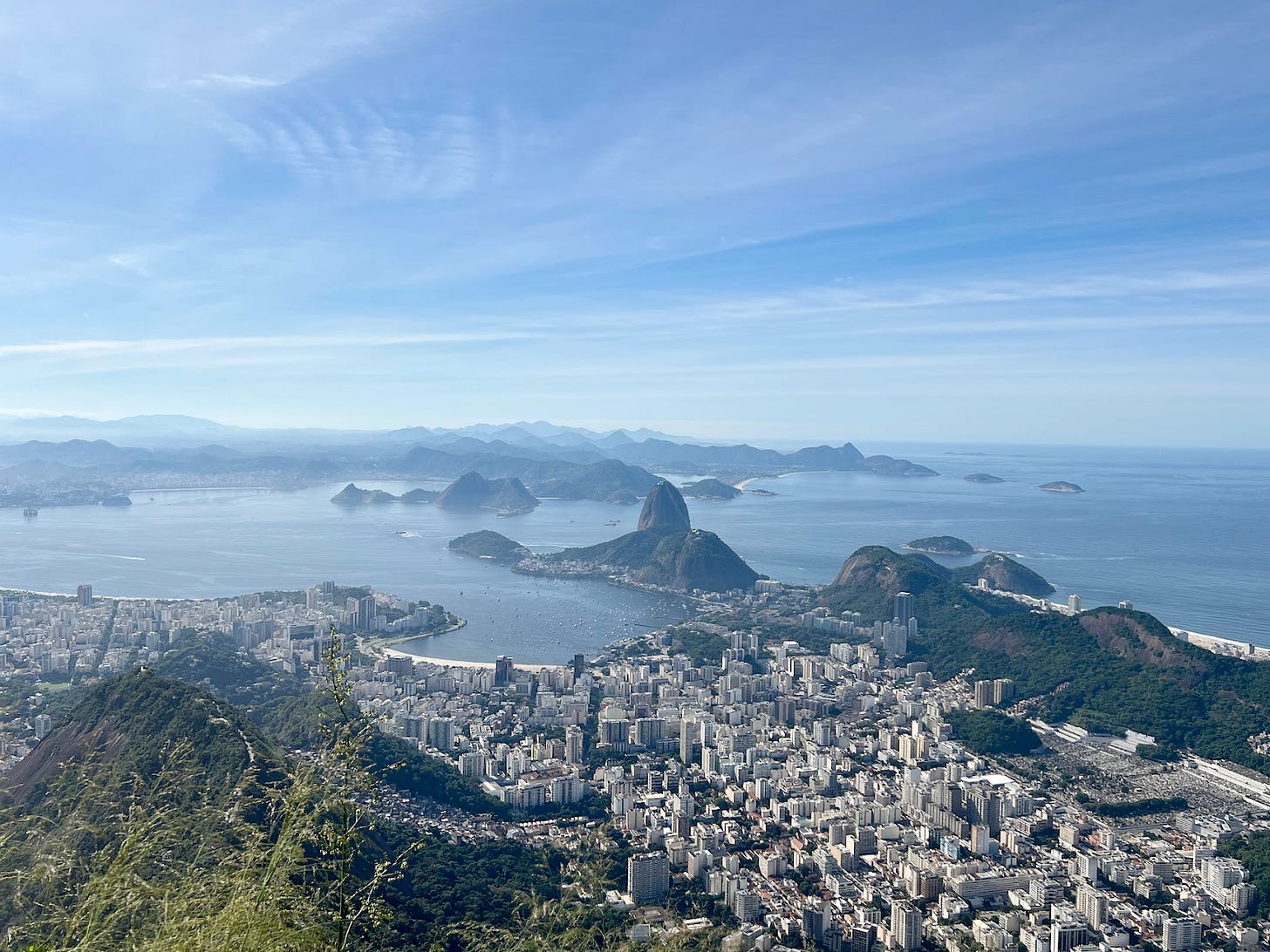Of Sun, Samba, & the Shadows of Slavery - Part I
A journey of colors and contrasts in Brazil.
Brazil is a land of colors and contrasts. Each city has its own rhythm, history, and spirit—but beneath the vibrant colors, upbeat music, and picturesque landscapes lies a complex history of struggle, resilience, and survival. It was the last country in the Americas to abolish slavery (in 1888), and it’s estimated that nearly 4 million Africans were brought to Brazil during the transatlantic slave trade—far more than any other country in the Americas. The scars of that history are woven into the very fabric of Brazilian society, from its food and music, to the very shape of its cities and the identities of its people.
Like many of my trips in recent years, I traveled halfway across the world for a work conference in Brazil and piggy-backed a personal trip to explore what I could in the time and budget I had. Beyond the typical associations most Indians have with Brazil—football, the Amazon rainforest, and Ayahuasca—I knew little about the country’s history, food, culture, or music. So, in every sense, this trip was an education of sorts—one shaped by observation, reading, immersive travel experiences, and insightful interactions with locals.
My journey began in Guarujá, a relaxed coastal town, before heading to the iconic Rio de Janeiro, a city that needs no introduction. Next, I explored Salvador de Bahia, Brazil’s cultural capital, and concluded my trip in the bustling metropolis of São Paulo. My trip was a mix of group and solo travel, giving me the best of both worlds. That said, I’ll admit, the time spent with my work friends was a lot more fun!
Chasing the Rising Sun in Guarujá
Guarujá is the kind of coastal town we see in old movies: pristine beaches lined with coconut trees and surrounded by the lush green Atlantic rainforest. The air smells like the sea: salty and refreshing, and the pace of life is invariably slow. Strolling along the beach in the wee hours of the morning (especially when you’re jet lagged), the warm colors in the sky leave you mesmerized, and the gentle waves beckon you to take a dip in the clear water. If you’re lucky, you might stumble upon sand dollars and crabs. It’s a place where time stands still, allowing you to truly soak in the beauty of the Brazilian coastline—even if it’s just for an hour before the work day pulls you in.
Although I didn’t get to explore much of Guarujá beyond the beach I was stationed at, I got a flavor of what Brazil had in store. I indulged in tapioca crepes with Brazilian yellow cheese and bacon every morning, ate too many pão de queijos (Brazilian cheese bread) than I will care to admit, drank enough lemon caipirinhas to know this would be my staple drink for the rest of my trip, and got a glimpse of samba reggae music, sparking my curiosity about the genre’s rich history.
Rio de Janeiro: A City of Colors and Contrasts
It was only in Rio that my vacation began, and I was accompanied by a few friends from work. We rented a cozy Airbnb in Copacabana, the tourist hub, which made it easy to head to the beach every morning, wander towards Ipanema with caipirinhas and churros in hand by evening, and grab an Uber whenever we wanted to explore the city. The infectious party vibe of Rio pulses through this area, with seafront resto-bars and street vendors selling yellow and green Brazil t-shirts, cheap sarongs, souvenirs, and braided bands. At any hour, you’ll find people jogging, playing beach volleyball and football, hitting the open-air gyms, swimming in the ocean, sipping drinks by the shore, swaying to samba beats, and strolling through the streets in their swimwear.
Our first two evenings in Rio were spent just walking around, trying to get a sense of the neighborhood and taking in the energy of the place. The lemon, mango, strawberry, and passion fruit caipirinhas (Brazil's national cocktail made with cachaça—a Brazilian rum-like liquor made from sugarcane) were always on point, and our favorite way to unwind was to catch live samba music while enjoying our drinks by the beach.
But there’s more to Rio than its party culture and laid back beach life. Look a little deeper and the shadows appear.
Exploring Pequena África on Foot
One of my favorite experiences in Rio was exploring Little Africa. Pequena África is a vibrant neighborhood at the heart of the city and was once home to the first African slaves brought to Brazil. Afro-Brazilian culture marks the streets, with colorful murals, bustling markets, and samba beats echoing from local bars. The scent of traditional dishes like feijoada (a rich black bean stew) fills the air, while the cobbled streets and colonial buildings tell stories of resistance, resilience, and celebration.
To gain a deeper understanding of the neighborhood and its rich, layered history, we joined Eddie, a local guide by day and samba dancer by night, for a walk through the heart of Pequena África. As we meandered through its narrow alleys and favelas—informal settlements of the descendants of enslaved Africans—Eddie shared stories of the transatlantic slave trade, the history and evolution of samba music, the iconic Rio Carnival, and the celebration of diversity in the neighborhood. “Everyone is welcome in Little Africa. People of all genders, sexualities, races, and lifestyles are celebrated here.”
He also explained, “The Rio Carnival is not just a party; it’s a competition!" Samba schools compete with one another, while the streets come alive with endless blocos, where both locals and tourists dance to samba rhythms, sip caipirinhas, and don vibrant costumes. “When in Rio, you must do two things,” Eddie exclaimed. “Find a football team to support, and find a samba school to cheer for!"
A key highlight of the walk with Eddie was tasting Mamata—a delicious alcoholic drink made with passion fruit, ginger, sugar, and alcohol, and found only in three bars in Pequena África. We downed our drinks in no time, bought a bottle for later, and proceeded to check out the murals of the samba greats.
One of them was of Tia Ciata, regarded as one of the unsung heroines of samba’s evolution, a legendary figure who helped shape the genre in its early days. Born in Bahia, she later moved to Rio and became a central figure in the Afro-Brazilian community, hosting samba gatherings at her home. These informal sessions brought together musicians, poets, and dancers, creating the space for samba to evolve from its roots in African rhythms into the vibrant urban genre it is today. Alongside Tia Ciata, other pioneering figures like Pixinguinha, Donga, and Heitor dos Prazeres also played crucial roles in the formation of samba, mixing traditional African beats with Brazilian melodies and instruments. Their contributions helped samba gain recognition beyond the Afro-Brazilian community, eventually becoming the heartbeat of Rio’s carnival and a symbol of Brazilian culture. Tia Ciata’s legacy, in particular, endures as a reminder of how the genre’s roots in Afro-Brazilian traditions were nurtured and celebrated in the face of racial and social challenges. You can read more about her, samba culture, and the Rio carnival here.
Little Africa serves as a living, breathing homage to the legacy of Afro-Brazilians, their struggles, contributions, and unbreakable connection to the land they helped shape, despite little recognition for the same. Eddie shared that Black people were generationally enslaved, much like how the caste system operates in India, while other forms of slavery were more transient in nature.
While Pequena África is a relatively new neighborhood, many skeletons have been found during home restorations. Initial speculation suggested that the area may have been a graveyard, but after checking the city map, they realized there was never a graveyard––just informal burial grounds. Being close to a port where enslaved Africans were brought to Brazil, many of them lived and died in the area, and the skeletons possibly belong to them. As the neighborhood developed over time, these burial sites were covered by urban expansion. Initiatives like the Museum of Afro-Brazilian History and Culture seek to preserve history and make known the neighborhood’s painful past that is often brushed under the carpet.
Shaking A Leg to Samba Music
Samba, with its deep African roots, evolved as a form of cultural expression in the face of oppression. Originally a way for enslaved people to preserve their heritage, samba gatherings became acts of defiance, where rhythm and dance told stories of survival and strength. Similarly, capoeira, a Brazilian martial art that combines elements of dance, acrobatics, music, and fight techniques, was developed as a disguised form of self-defense. Enslaved Africans, forbidden from practicing martial arts, created capoeira as a way to train their bodies for resistance, hiding their movements within dance and acrobatics. By blending fighting techniques with rhythmic movements, capoeira became a tool of empowerment and a subtle challenge to their oppressors. Today, both samba and capoeira are celebrated as powerful symbols of Afro-Brazilian identity, reflecting the indomitable spirit of resistance, survival, and the joy of freedom.
After learning so much about the history of samba, it was only natural that we wanted to give it a shot. So we looked up samba classes for beginners and signed up for one. It was a lot of fun, despite having two left feet, and I have my work friends to thank for the experience. We also hoped to take a Capoeira class but unfortunately didn’t get the chance. Next time!
Checking off the Tourist Landmarks: Cristo Redentor & Sugarloaf Mountain
If India is synonymous with the Taj Mahal in the west, Rio is synonymous with Christ the Redeemer, one of the Seven Wonders of the World and a UNESCO World Heritage Site. We couldn’t have possibly left Rio without paying homage to Cristo Redentor (Christ the Redeemer)—visible from all parts of the city, and Pão de Açúcar (Sugarloaf Mountain)—two of Rio’s most famous landmarks. Both offer breathtaking views of the city, ocean, islands, and surrounding forest, and are worth a visit on a clear day.
The Hidden Gems of Rio
Rio, despite being one of the most famous cities in the world, continues to have several hidden gems that usually don’t make it to the tourist itinerary. One of them is Ilha da Gigóia, a charming little island nestled in the Lagoon of Barra. Accessible only by boat, the island is known for its cozy vibe, picturesque waterfront, and small, traditional restaurants that serve seafood dishes. It's the perfect spot for a quiet escape, and we spent the morning exploring the island on foot and wading through the mangroves by boat. We spotted a handful of crocodiles, a lone capybara, and got bitten by too many sand flies.
Since I missed a day trip to the popular Ilha Grande because of my damn period, I tried to make up for it by hopping over to another hidden gem recommended by a local: Praia de Grumari, a quiet beach in the outskirts of the city. Away from the crowds of Copacabana and Ipanema, Grumari offered tranquil views, a mesmerizing sunset, and chilly waters—the perfect setting to conclude this leg of my trip.
As you may have gathered by now, Brazil is a country where resilience meets celebration, and my time in Rio was a powerful reminder of how history shapes our identities, but also how the spirit of survival and joy can rise from even the darkest chapters. More in Part II of this series, where I write about my time in Salvador de Bahia, Brazil’s first colonial capital and the central hub of the transatlantic slave trade, and São Paolo! Stay tuned.



















Lovely read. Great pics.
Tapioca - a Portuguese legacy from Brazil to India.
Excellent. So to learn from in this write-up and a reminder for me that no one else can write with such a light touch. Have been meaning to go and this has added to it. Brilliant photos too!